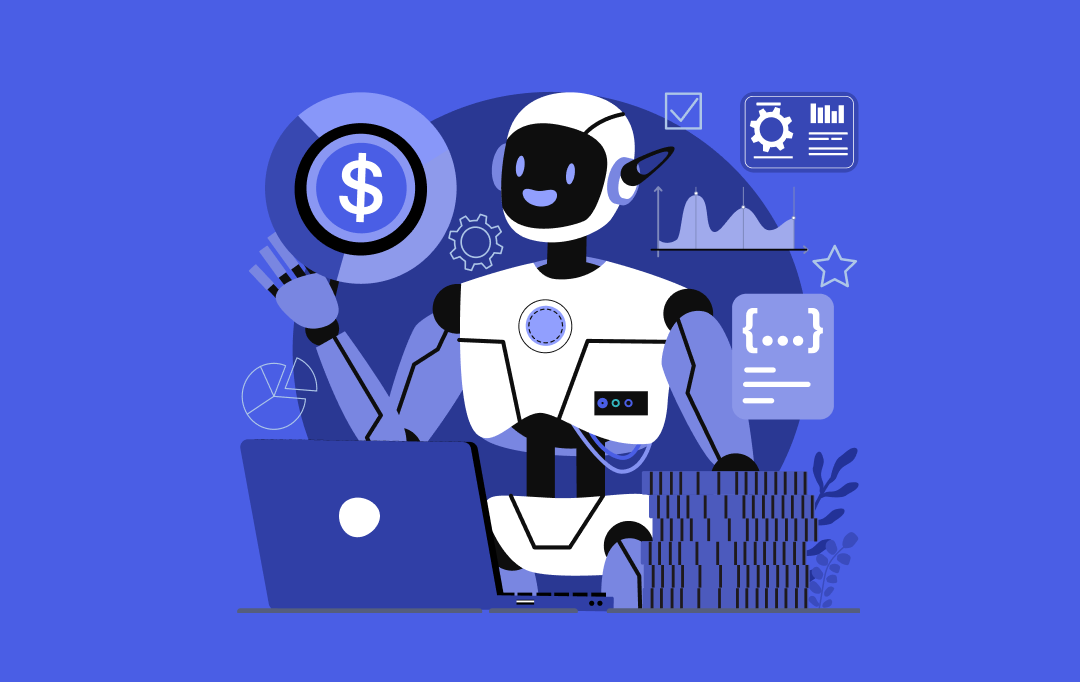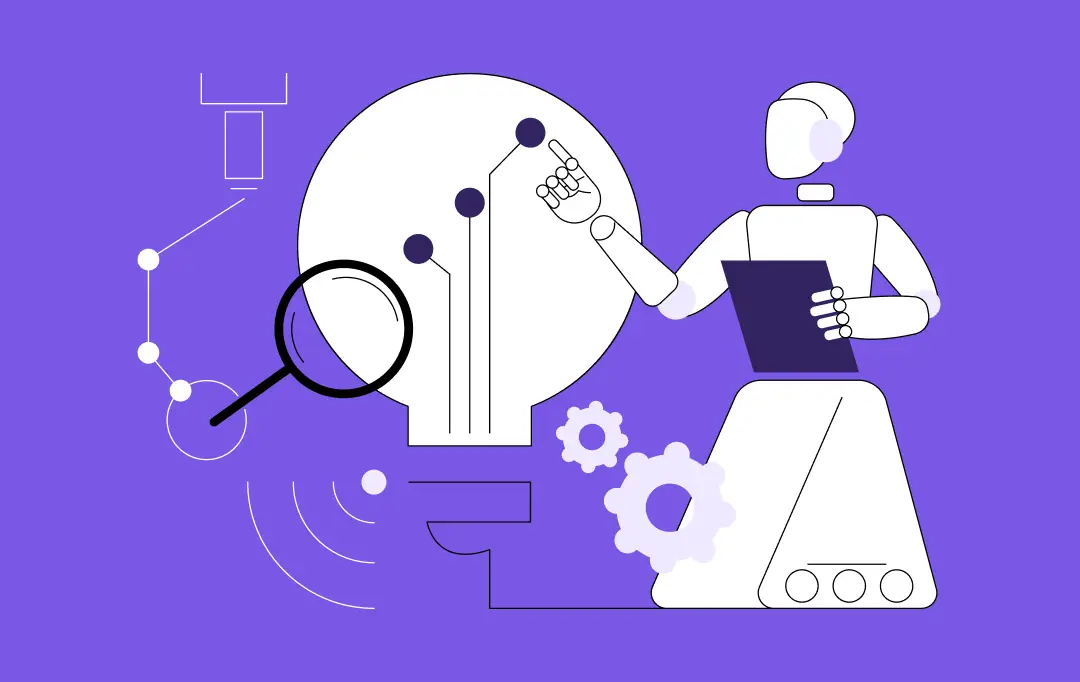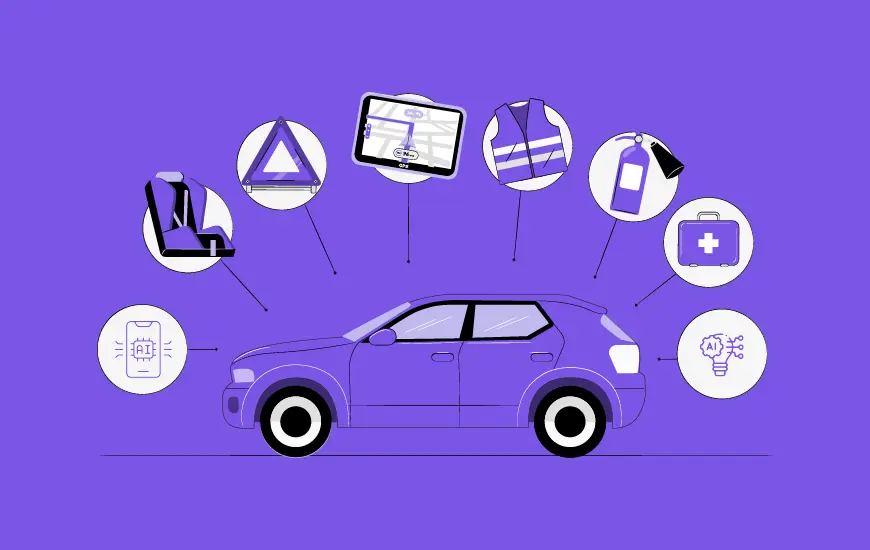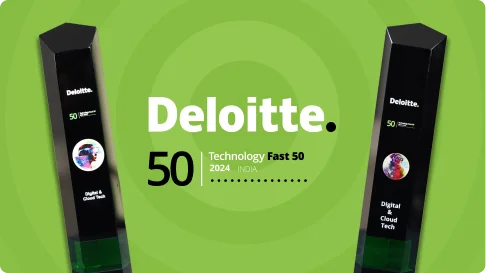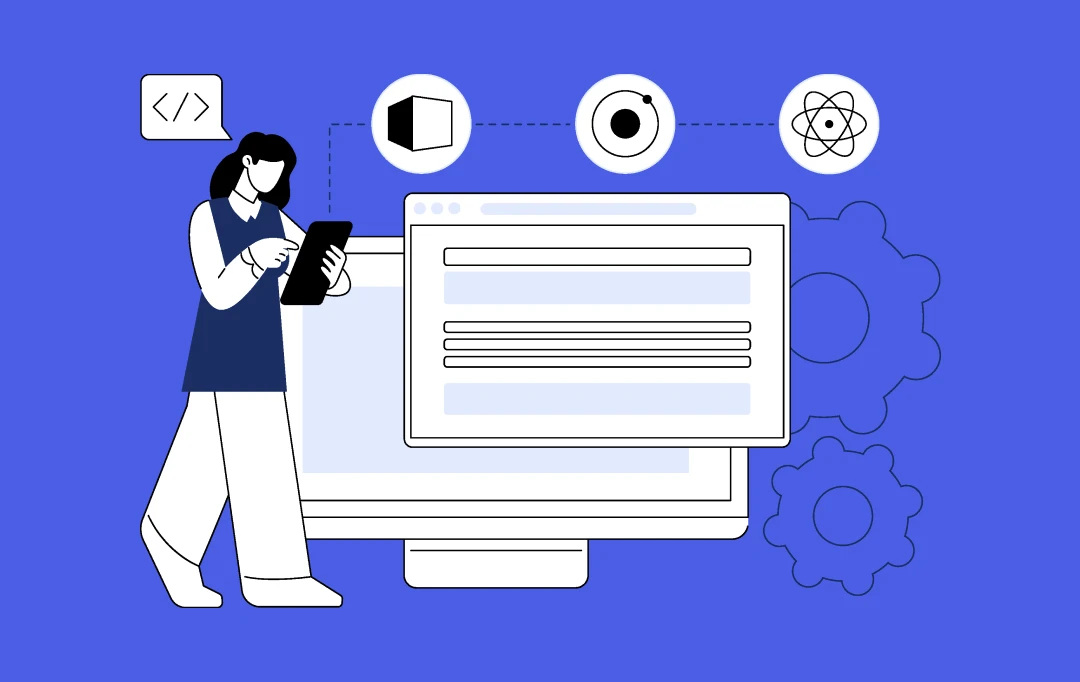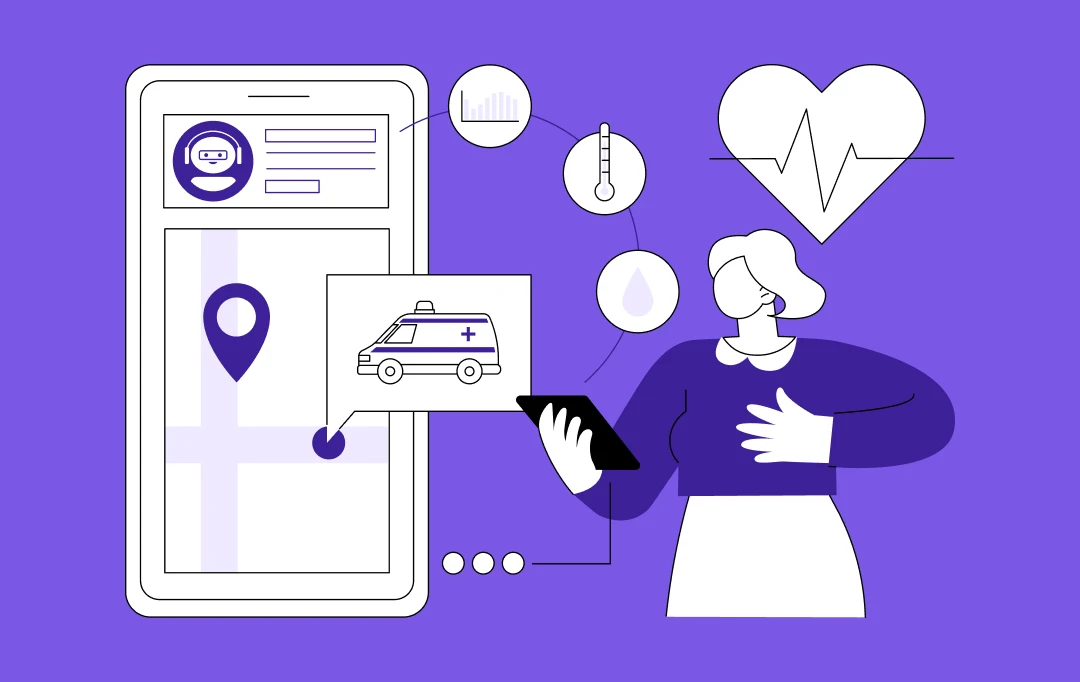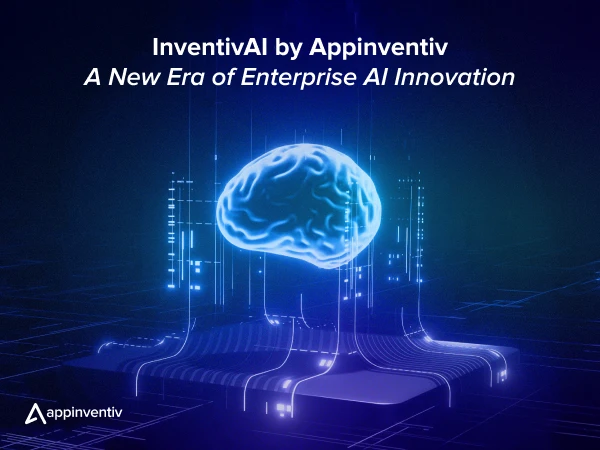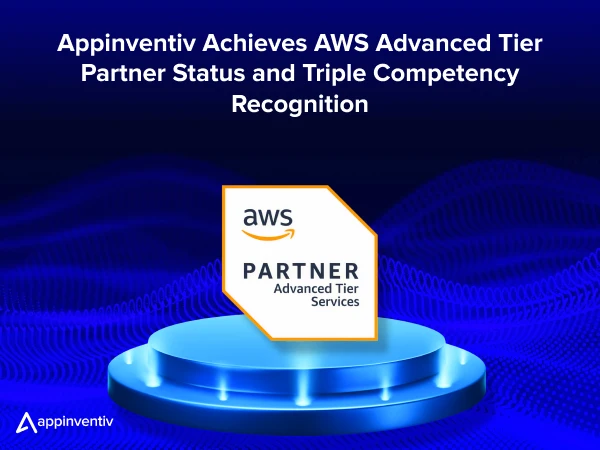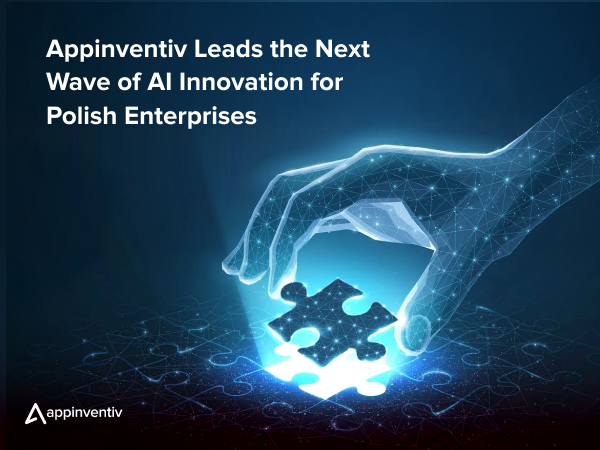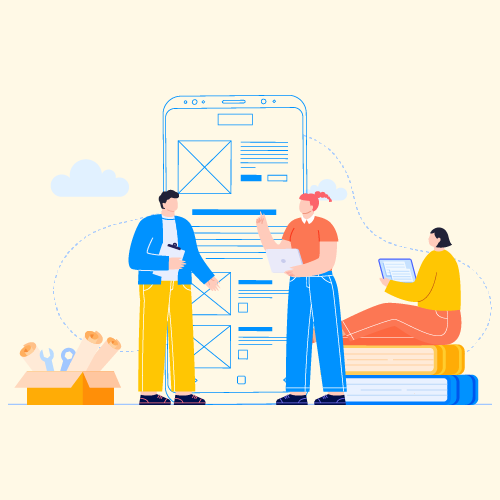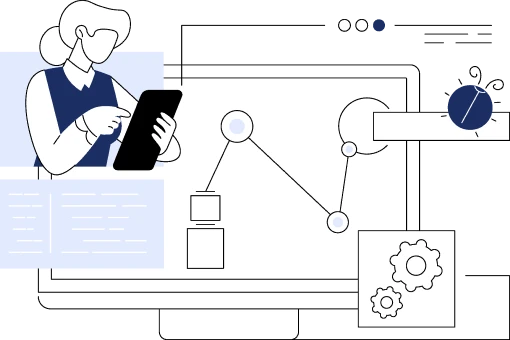- Understanding Large Language Models (LLMs)
- How Do Large Language Models Actually Work?
- Why Enterprises Should Embrace LLMs
- Industry-Wise Use Cases of LLM Models Driving ROI
- Finance
- Healthcare
- Legal
- Manufacturing
- Retail and eCommerce
- Education
- Real Estate
- How Organizations across Industries are Using LLM Models: Applications & Advantages
- Powering Customer Service
- Creating Content at Scale
- Boosting Employee Productivity
- Real-World Examples of Companies Putting LLMs to Work
- Octopus Energy
- Netflix
- Bank of America
- DaveAI
- Duolingo
- Buy, Customize, or Build an LLM?
- Buy: Using Off-the-Shelf Foundation Models
- Customize: Fine-Tuning a Foundation Model
- Build: Creating a Custom Language Model from Scratch
- How to Develop an LLM Model
- Comprehensive Planning
- Data Collection and Preparation
- Model Architecture Selection
- Model Training & Fine-Tuning
- Evaluation and Iteration
- Keeping LLMs Secure and on Track
- Model Deployment Strategies
- Continuous Monitoring and Updates
- Optimize LLM Inference in Production
- Challenges in Developing LLM Models for Enterprises and How to Overcome Them
- Data Availability and Quality
- Resource Management Headaches
- User Adoption and Trust Issues
- Dealing with Bias and Fairness Problems
- Scalability Nightmares
- Regulatory Compliance Chaos
- Estimating LLM Development Costs & Timeline
- Cost Optimization Strategies for Large-Scale LLM Deployment
- The Future of LLMs in Enterprises
- The Rise of the Specialist
- LLMs as Co-Workers
- The Age of “LLM Agents”
- Begin Your LLM Journey with Appinventiv
- FAQs
Key takeaways:
- Developing an LLM can mean fine-tuning a foundation model, not always building from scratch.
- Data quality and security are the most critical factors in enterprise LLM development.
- The “build vs. buy” decision depends on your use case, budget, and data privacy needs.
- Successful deployment requires a strategic LLM development framework covering security, monitoring, and cost optimization.
- LLM development cost is a significant investment, but the ROI from automation and innovation can be substantial.
A few years ago, large language models were a tech curiosity, a fascinating glimpse into the future. But today, they are the engine fueling the next wave of business innovation. The shift is dramatic and undeniable.
For example, OpenAI’s GPT-3, a leading LLM that powers virtual assistants, enhances customer interactions, and streamlines business workflows. According to a 2025 McKinsey report, 78% of organizations are already using AI in at least one business function, up from 72% from the previous year.
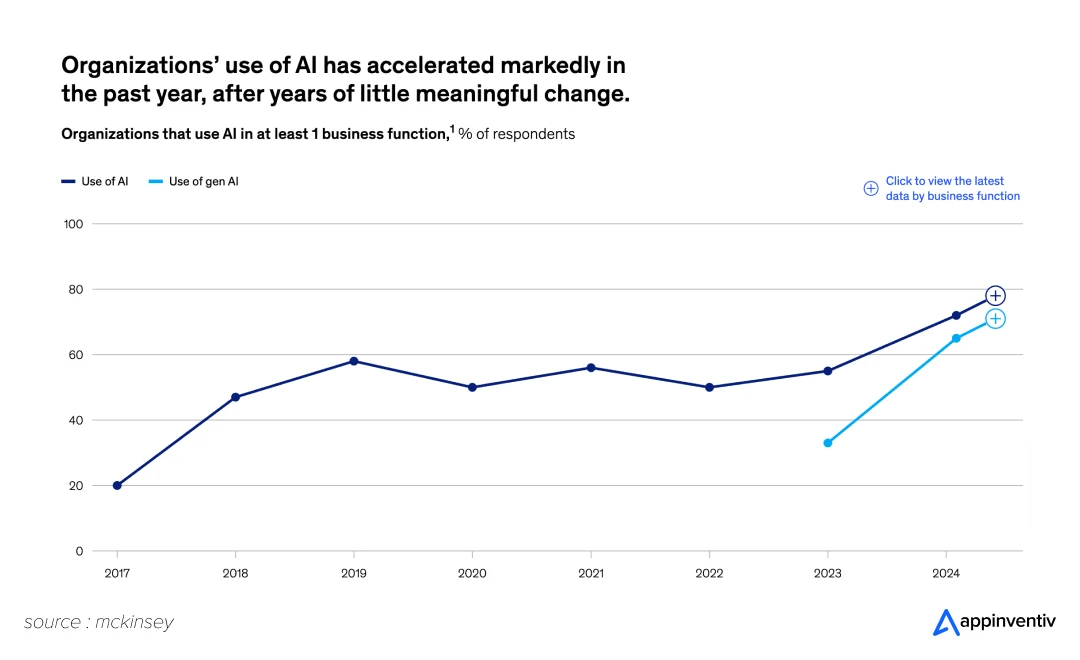
This isn’t just about buzz; it’s about real-world value. From automating tedious tasks to unlocking new revenue streams, LLMs have moved from the lab to the core of enterprise strategy.
But here’s the thing – most companies are essentially using the same toolbox, which means they are not really creating any meaningful competitive edge. The real magic happens when you understand how to develop LLM models that actually fit your specific business needs.
This enterprise LLM development guide will provide a clear, step-by-step roadmap for business leaders, product heads, and innovation leads on how to develop an LLM model. We’ll cut through the jargon to give you a practical understanding of the entire LLM development process, from strategic planning to deployment and maintenance. Our goal is to equip you with the knowledge to make informed decisions and transform your enterprise with custom AI.
Understanding Large Language Models (LLMs)
Large Language Models are incredibly digital minds that have read practically everything on the internet. These AI systems get trained on massive collections of text – we’re talking books, articles, websites, you name it. A 2025 Hostinger report noted that the 5 leading LLMs collectively generate around 88.22% of the global market revenue.
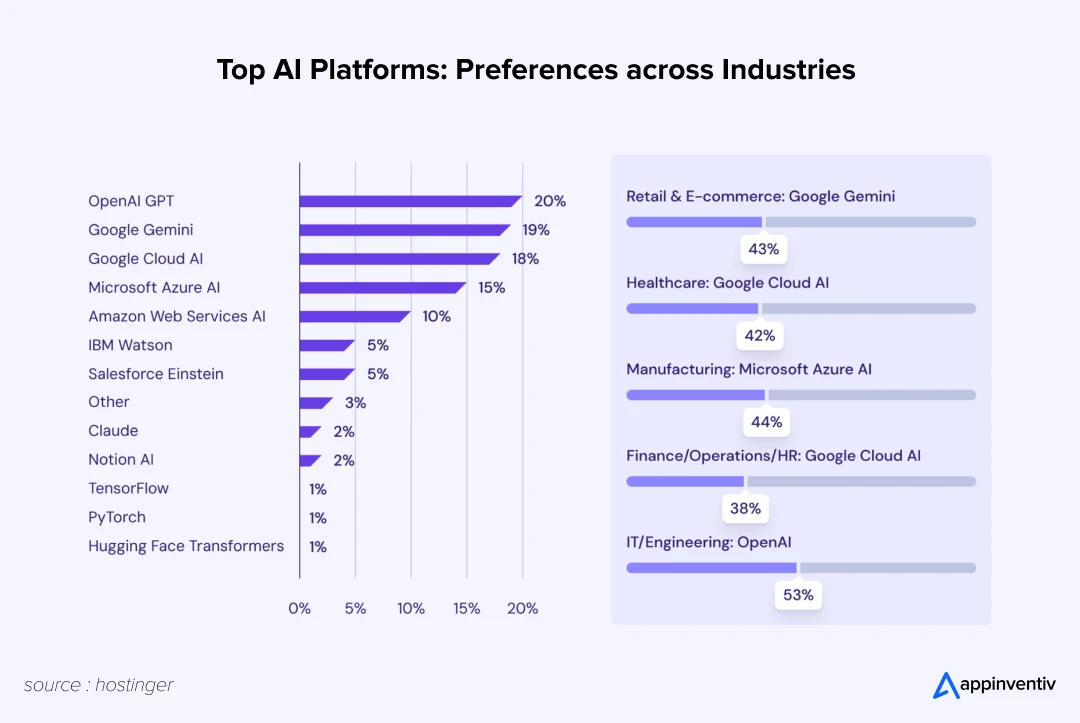
You would have already heard a lot about the big players in this space, such as OpenAI’s ChatGPT, Bert, T5, Google’s Gemini AI, etc.
- ChatGPT excels at generating text that sounds natural and conversational.
- BERT is fantastic at understanding context and meaning.
- T5 treats every single task as a text-to-text problem, which sounds simple but is actually quite clever.
- Gemini AI understands and operates across text, images, and other media.
How Do Large Language Models Actually Work?
To truly appreciate the power of LLMs, it helps to understand, at a high level, how they function under the hood. Most modern LLMs are built on what’s known as the “transformer” architecture—a breakthrough in deep learning introduced in 2017. Unlike earlier models that processed language one word at a time, transformers can analyze entire sentences or paragraphs simultaneously, allowing them to grasp context, nuance, and relationships between words.
A key innovation is the “attention mechanism,” which lets the model focus on the most relevant parts of the input text. Think of it as a way for the model to decide which words in a sentence matter most for understanding the meaning. This is what enables LLMs to generate coherent, contextually appropriate responses and to handle complex tasks like summarization, translation, and even reasoning.
What makes a language model “large” is the sheer number of parameters—the adjustable weights inside the neural network. Today’s LLMs can have billions (or even hundreds of billions) of these parameters, which is why they require so much data and computing power to train, but also why they’re so adept at understanding and generating human language.
Why Enterprises Should Embrace LLMs
Here’s where things get really interesting for business leaders. LLMs aren’t just fancy chatbots – they’re strategic tools that can automate those mind-numbing repetitive tasks that eat up your team’s time, help make better decisions by analyzing data in ways humans simply can’t match, and create personalized experiences for customers at a scale that would be impossible otherwise.
30% of enterprises are poised to automate over 50% of their network operations using AI and LLMs by 2026. This adoption is spread across multiple industries.
Let me give you some real examples. In the finance world, these models are analyzing market trends and sifting through regulatory documents that would take human analysts weeks to process. Healthcare organizations are using them for clinical documentation and patient communication – imagine having a system that can help doctors write better notes and communicate more clearly with patients. Legal firms are revolutionizing contract review and compliance monitoring. And customer service teams? They’re deploying LLMs for round-the-clock support that actually understands what customers are asking.
Let’s understand the use cases of LLMs in detail in the section below:
Industry-Wise Use Cases of LLM Models Driving ROI
The applications of LLMs in organizations are diverse and growing rapidly across industries. 67% of organizations worldwide have adopted LLMs, and 88% of professionals report that using LLMs has improved the quality of their work:
Finance
In the BFSI market, LLMs are widely used for fraud detection. They can spot unusual patterns in transactions. They also analyze financial news and reports to help traders make better decisions. Investment firms are using LLMs for market analysis and portfolio optimization in ways that would have seemed like magic just a few years ago.
Healthcare
Healthcare is moving fast on this: In the US, 21% of healthcare organizations are using LLMs to answer patient questions, while 20% have deployed medical chatbots. Another 18% are applying these models for biomedical research. Beyond that, you’re seeing clinical coding (17%) and medical text summarization (16%) becoming common applications. Imagine cutting down documentation time for doctors while improving accuracy – that’s the kind of impact we’re talking about.
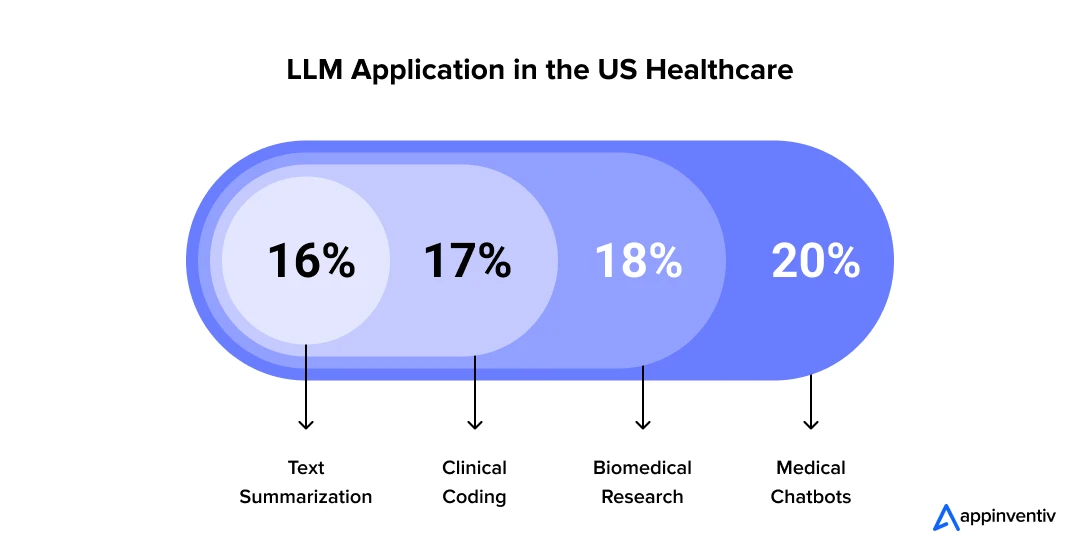
Legal
Lawyers use LLMs to review massive legal documents. AI in the legal industry can quickly find relevant clauses and flag potential issues. This makes the due diligence process much faster and more efficient.
Manufacturing
LLMs are helping to make everything run more smoothly on the factory floor. They can take a super-dense technical manual and turn it into a simple, conversational guide. An operator can just ask a question like, “How do I fix this conveyor belt?” and get an instant, easy-to-understand answer. This saves a ton of time and training effort. LLMs are also great at looking for patterns in data from sensors. This helps predict when a machine might need maintenance, so companies can fix it before it breaks down. This prevents costly interruptions and keeps production moving.
Retail and eCommerce
Retail and eCommerce hold the largest segment in the LLM market, accounting for a 27.5% share. LLMs are behind a lot of things in the online shopping market. Imagine not having to type in exact keywords to find something. Instead, you can describe what you want in your own words, like “I need a light jacket for spring weather.” The LLM understands your intent and shows you perfect options. These models can also write product descriptions and marketing copy automatically. This helps businesses save time and keep their product listings fresh. And when you have a question about an order, an LLM-powered chatbot can give you an immediate, helpful response around the clock.
Education
LLMs are like a new kind of teaching assistant. For students, they can act as a personal tutor. They explain difficult topics in a different way or provide extra practice problems. This creates a learning path that’s just for you. For teachers, LLMs are a huge help with administrative tasks. They can automatically grade assignments and give feedback, which frees up time for more one-on-one interaction with students. They can also help teachers create new lesson plans and quizzes quickly, making it easier to build engaging classroom material.
Real Estate
Buying or selling a home can be a complicated process, but LLMs are simplifying it. They can help potential buyers search for homes in a more natural way. A person could ask for “a quiet house with a big backyard that’s close to a good school,” and the LLM can find listings that fit that description. For real estate professionals, LLMs are great for drafting and summarizing legal documents like leases and contracts. They can even flag potential risks in the paperwork. This saves a ton of time and helps everyone involved move through the process faster and with more confidence.
How Organizations across Industries are Using LLM Models: Applications & Advantages
As said above, organizations in different industries are putting LLMs to work in surprising and innovative ways. They are moving beyond simple chatbots to leverage these powerful tools for everything from boosting employee productivity to creating more personalized customer experiences.
While the applications of LLMs are unique to specific industry needs, there are some common use cases that nearly every industry applies to in its day-to-day operations. Lte’s uncover them:
Powering Customer Service
The most obvious use case, right? But it’s getting smarter. It’s not just “Hello, how can I help you?” anymore.
- Supercharging chatbots. LLMs let chatbots understand complex, nuanced questions. They can handle conversations that feel much more human. This means customers get faster, more accurate answers.
- Helping human agents. LLMs act like a co-pilot for customer service reps. They can quickly summarize a customer’s history. They can suggest the best response in real-time. This frees up the human to focus on solving the real problem.
- Analyzing feedback. Think about all the customer emails, reviews, and social media posts a company gets. LLMs can read through it all and identify trends, informing companies what people love and what they hate. This is invaluable for improving products and services.
Creating Content at Scale
Content creation used to be a long, manual process. But LLMs have changed that.
- Drafting documents. From marketing copy to internal memos, LLMs can generate a first draft in seconds. This saves a ton of time for writers and marketers.
- Generating personalized content. Imagine creating thousands of unique product descriptions or creating personalized email campaigns for different customer segments in seconds! Sounds amazing, right? LLMs make this possible, tailoring content to specific audiences.
- Translating and localizing. Companies are global. LLMs can translate content quickly and accurately. They can even adapt it for cultural nuances. This helps businesses reach new markets much more easily.
Boosting Employee Productivity
LLMs aren’t just for customer-facing roles. They are being used to make employees’ jobs easier across the board.
- Automating research. Need to get up to speed on a new topic? An LLM can summarize a pile of research papers or reports. It can pull out the key findings and present them in a clear way.
- Enhancing data analysis. LLMs can organize unstructured data in seconds. They can extract key information from the piles of documents. This helps analysts find the data they need without manual searching.
- Writing and debugging code. This is a huge one for software companies. LLMs can generate code snippets or even entire functions. They can also help developers find and fix bugs faster. This dramatically speeds up the development cycle.
Real-World Examples of Companies Putting LLMs to Work
Companies aren’t just talking about LLMs; they are putting them to use in powerful ways right now. From customer service to marketing, these models are changing how businesses operate.
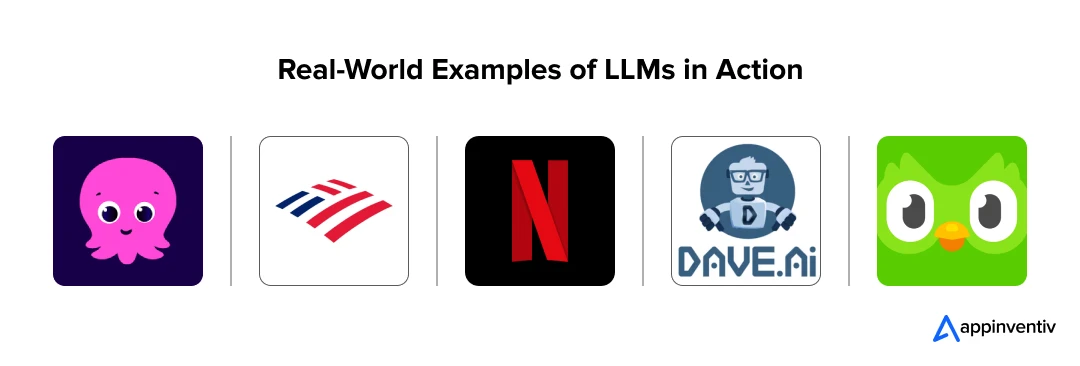
Octopus Energy
This energy company in the UK has a smart approach. They’ve integrated a model like ChatGPT into their customer service. This AI now handles nearly half of their customer inquiries. What does this mean? It means a lot of the simple questions get answered instantly, and the human support team can spend their time on the tough, tricky problems that need a real person’s touch.
Netflix
Netflix is always trying to get better at recommending shows. They are moving away from their old system and using LLMs to understand their users even better. The LLM sees every little thing you do—what you watch, when you pause, and even how you scroll. It treats these actions like words in a sentence to figure out your viewing habits. This helps the platform suggest shows you might not have found otherwise.
Bank of America
In the financial world, security and good customer service are a big deal. Bank of America is serving 60% of its clients using LLM-based solutions for investment planning. The bank uses an AI-driven virtual assistant called Erica that has handled billions of customer interactions, helping with everything from balance inquiries to setting up fraud alerts. This frees up human bankers to handle more complex financial advice and planning. The bank has also given over 95% of its employees access to AI tools, helping them summarize documents and write reports faster.
DaveAI
This company helps other businesses try out AI without making a big commitment. They let enterprises use various powerful tools, like GPT, Bard, and even Midjourney, all in one place. This lets businesses experiment and find the right technology for their needs before they fully invest in a single platform. It’s like a sandbox for AI tools.
Duolingo
The popular language learning app, Duolingo, invested in GPT-4 to make learning feel more personal. They introduced a feature called Duolingo Max. This tool goes beyond basic translation. It acts like a real teacher, giving learners detailed explanations about their mistakes and offering deep insights into the language. It’s making the learning experience much richer.
Also Read: How Much Does Duolingo like App Development Cost?
Buy, Customize, or Build an LLM?
This is the first and foremost decision in your enterprise LLM development project. Do you want to use an off-the-shelf model, fine-tune one, or ready to build a custom model from scratch? Identify your unique business needs, market demands, available resources, and budget before making a final choice. To help you make an informed and right decision, here is what to choose and when
Buy: Using Off-the-Shelf Foundation Models
Foundation models like GPT-4 or Llama 3 are large, pre-trained models that can be used directly via an API. They offer a strong starting point and can handle a wide range of general tasks with impressive accuracy. The primary advantage is speed to market and lower LLM development cost. You don’t need a dedicated team of machine learning services experts or massive computing resources.
However, these models fail to comprehend your company’s unique jargon or internal processes, and their data privacy policies are set by the provider.
Customize: Fine-Tuning a Foundation Model
Foundation models are like getting a really smart intern who already knows a lot about the world – you just need to teach them your specific business. Pre-trained models like GPT-4, Claude, or open-source alternatives give you robust capabilities without having to start from scratch or break the bank.
Foundation models make perfect sense when you need to get something up and running quickly, when your team doesn’t have deep AI expertise yet, or when you want to test the waters before making bigger investments. They’re particularly good at general language tasks and can be adapted through clever prompt engineering – basically, learning how to ask them questions in ways that get you better answers.
But let’s be honest about the limitations. A one-size-fits-all model may not understand your company’s specific jargon, internal processes, or customer base. That’s where customization comes in. You can fine-tune LLM models by training them on your proprietary data. This process, known as fine-tuning, adapts the model’s behavior to your specific domain, making it more accurate and relevant.
Also, you don’t have control over the underlying architecture, you’re dependent on external providers (which can be risky), and you might run into data privacy concerns. Plus, costs can really add up if you’re processing large volumes – those per-token charges can surprise you.
Pros of Foundation Models:
- Fast deployment.
- Lower development costs.
- Minimal data required for fine-tuning.
Cons of Foundation Models:
- Limited to the pre-trained capabilities.
- Requires further fine-tuning for specific tasks.
Build: Creating a Custom Language Model from Scratch
Building an LLM model from scratch is a massive undertaking, typically reserved for tech giants. The cost to develop a custom LLM for a large corporation can run into the tens of millions of dollars. However, the benefits of owning your own model can be immense. You gain complete control over your data, ensuring maximum security and compliance with regulations like GDPR or HIPAA. This is often the path for highly regulated industries like finance or healthcare.
A more realistic approach for most enterprises is to create a custom LLM for enterprises by starting with an open-source foundation model and fine-tuning it extensively.
This enterprise LLM development guide will focus on this hybrid approach in the next section, as it offers the best balance of performance, control, and cost for most businesses.
| Using an API | Fine-Tuning a Foundation Model | Building from Scratch | |
|---|---|---|---|
| Speed to Market | Very Fast | Fast | Very Slow |
| Cost | Low (Pay-per-use) | Moderate | Very High |
| Data Privacy | Relies on API provider’s policies | High (your data stays in-house) | Complete Control |
| Customization | Low (Prompt engineering) | High (Domain-specific knowledge) | Complete Control |
| Use Case | General tasks | Domain-specific applications | Highly specialized/sensitive tasks |
The decision to either use a pre-trained model or build a custom LLM depends on the specific needs of the enterprise and its LLM development budget.
How to Develop an LLM Model
The LLM model development process is a structured, multi-step journey. Whether you’re fine-tuning or building from the ground up, the core steps remain similar. Here is a step-by-step process of custom LLM development

Comprehensive Planning
The first step in the LLM development process is a discovery phase. What problem are you trying to solve? Is it customer support automation, internal knowledge retrieval, or something else entirely? Once you define the use case, you need to form your LLM development team structure for enterprises.
This should be a cross-functional team including data scientists, ML engineers, software developers, and domain experts from the relevant business unit. Alternatively, you can also hire a reputed AI development company to build a custom LLM tailored to your needs.
Data Collection and Preparation
Data is the lifeblood of any LLM. You’ll need to gather a high-quality, relevant dataset. This could include customer transcripts, internal documents, product manuals, or other proprietary text. Next, this data must be meticulously cleaned and prepared. A common LLM development framework for this involves tokenization, where text is broken down into smaller, numerical units that the model can understand. This process is crucial for preventing bias and ensuring the model learns from a clean, diverse source.
Here is a step-by-step process of cleaning and preparing the data:
- Cleaning: Remove irrelevant info, correct errors, standardize formats.
- Deduplication: Eliminate repeats and near-duplicates to avoid bias.
- Filtering: Exclude toxic, biased, or sensitive data.
- Tokenization: Break text into tokens (words or subwords) so the model can process it.
A well-prepared dataset improves quality and prevents issues like bias or overfitting.
Model Architecture Selection
Choosing the right architecture is a bit like picking the right foundation for a house – it affects everything else you build on top. Transformer-based models are dominating right now, but you should also consider alternatives like retrieval-augmented generation (RAG) if you’re working on knowledge-intensive tasks.
The number of parameters in your model makes a huge difference in both performance and resource requirements. You’re looking at anywhere from 7 billion parameters for specialized applications up to 175+ billion for general-purpose systems. The key is balancing what you need the model to do with what your infrastructure can actually handle.
Model Training & Fine-Tuning
This is where the magic happens. Training LLMs requires serious computational horsepower. For most enterprises, this means taking a pre-trained foundation model and fine-tuning it on your prepared dataset. This process updates the model’s parameters, teaching it the nuances of your business. The goal is to make the model not just smart, but smart about your company.
Evaluation and Iteration
After training, you must rigorously evaluate the model with both automated and human-centered methods. This isn’t just about a single LLM performance testing metric. You need to use both automated metrics and human-in-the-loop testing. Have your domain experts test the model’s outputs. Does it understand the company’s lingo? Are its responses accurate and appropriate? This feedback loop is essential for refining the model and addressing any weaknesses.
Keeping LLMs Secure and on Track
Security is not an afterthought; it must be baked into the LLM development process from day one. You need to implement strong access controls, encrypt data both at rest and in transit, and have a robust auditing system.
LLM data privacy is paramount, and your framework should prevent data leakage and unauthorized access. Thus, when you develop enterprise language models, you must ensure LLM compliance requirements are met. For instance, models handling customer data must comply with regulations like GDPR.
Model Deployment Strategies
When deploying your LLM, you have multiple choices, such as on-premises vs. cloud deployment, hybrid and serverless.
- Cloud deployment: Cloud deployment offers scalability and convenience, but it means trusting a third-party provider for your data and models.
- On-premises deployment: On the other hand, on-premises deployment gives you full control but requires a major upfront investment in hardware and expertise.
- Hybrid approach: Most enterprises opt for a hybrid model, using cloud services with a strong enterprise LLM security and data governance framework in place.
- Serverless Functions: For lightweight or event-driven use cases, serverless platforms like AWS Lambda or Google Cloud Functions are efficient.
LLM development tools like Kubernetes and Docker are indispensable here. This helps containerize the model for consistent deployment and scaling. You should choose the strategy that fits your security, budget, and usage needs.
Continuous Monitoring and Updates
LLMs, like any other applications, require ongoing maintenance. You must continuously monitor your model’s performance to detect a phenomenon known as “model drift,” where the model’s performance degrades over time as language patterns change. A robust LLM development framework includes automated monitoring tools that alert your team to potential issues, allowing them to continuously retrain and improve the LLM.
Optimize LLM Inference in Production
Inference is the process of generating a response from a trained model. For enterprise applications, this needs to be fast and cost-effective. Techniques like quantization and model batching can significantly improve latency and throughput. Quantization, for example, reduces the model’s size without a significant loss in accuracy, making it faster and cheaper to run. These optimizations are crucial for managing your LLM development cost.
Also Read: Build Your Enterprise AI Copilot: Development & Cost Guide
Challenges in Developing LLM Models for Enterprises and How to Overcome Them
Despite the numerous applications and advantages of custom LLM models, enterprises face several roadblocks in leveraging their power to the fullest. But don’t worry. You can easily overcome those barriers with the right approach and strategies. Let’s have a quick look at some common challenges of LLM development and ways to overcome them:
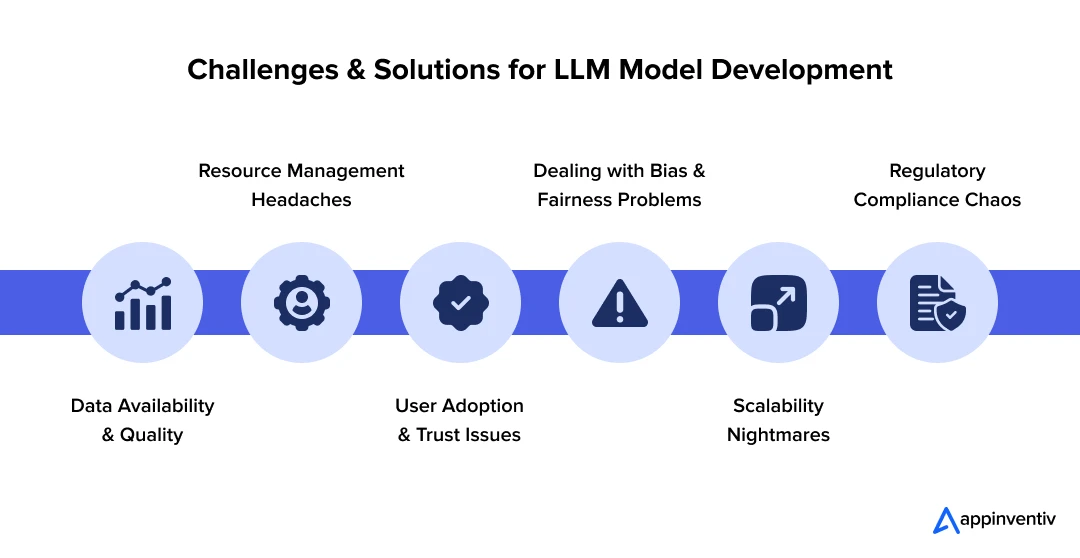
Data Availability and Quality
- Problem: You know what’s funny? Most companies think they have tons of data until they actually try to use it for LLM training. Suddenly, they discover their “treasure trove” of information is scattered across tons of different systems, half of it is duplicated, and the other half wouldn’t pass a basic quality check.
- How to Fix It: Start with a proper data audit. It means you need to dig into what you’ve got. Create data discovery processes that don’t just find your information but actually evaluate its usefulness. Sometimes your biggest competitor can become your best data partner through industry consortiums. Sounds weird, but it works. Build automated quality checks that catch problems before they poison your model. And when you’re still coming up short? Synthetic data can fill gaps, but don’t get lazy – crappy synthetic data will give you a crappy model.
Resource Management Headaches
- Problem: Here’s what nobody tells you upfront – LLM development is expensive as hell. Not just the obvious costs like GPUs and cloud bills, but the hidden stuff that sneaks up on you. Energy costs that make your CFO’s eye twitch. Infrastructure that seemed reasonable during testing but explodes when you scale up.
- How to Fix It: Cloud platforms are your friend, but use them strategically. Scale up for training sprints, then scale back down – don’t leave expensive resources running idle because you forgot about them. Partner with universities for fresh talent and research collaboration. Sometimes hiring AI consultants for specific phases costs less than trying to build expertise from scratch. And here’s a pro tip: managed AI services might seem expensive upfront, but they can save you from hiring three specialized engineers.
User Adoption and Trust Issues
- Problem: You can build the most technically perfect LLM in the world, but if your users don’t trust it, it is of no use. People are scared of making mistakes and being replaced. These fears are real and rational, and you can’t engineer your way around them.
- How to Fix It: Show your staff exactly how the AI helps them rather than threatens them. Ensuring transparency in how the LLM works, providing explainable AI outputs, and offering robust training to users can help build trust and ease adoption.
Dealing with Bias and Fairness Problems
- Problem: Your LLM can accidentally become a discrimination machine if you’re not careful. It learns from data that reflects human biases, then amplifies them in ways that can torpedo your reputation and land you in legal battle. Imagine explaining to your board why your hiring AI systematically rejected qualified candidates from certain backgrounds.
- How to Fix it: Build bias testing into your development process from day one, not as an afterthought. Use diverse training datasets and diverse testing scenarios. Create review boards with people from different backgrounds who can spot problems you might miss. Implement ongoing monitoring that catches bias drift in production. And establish clear escalation procedures for when things go wrong – because they will, despite your best efforts.
Also Read: Navigating Responsible AI Principles: A Dive Into Ethical AI Practices
Scalability Nightmares
- Problem: You know your LLM project is succeeding when it starts breaking under its own success. What worked fine for 100 users starts crawling when you hit 10,000. Response times that seemed acceptable during testing become user-frustrating delays in production.
- How to Fix It: Design your architecture with scaling in mind, even if you’re starting small. Use container orchestration that can handle traffic spikes automatically. Implement caching strategies for common queries – why recompute the same answer a thousand times? Plan your data pipeline to handle growing volumes without manual intervention. And monitor everything – you can’t optimize what you can’t measure.
Regulatory Compliance Chaos
- Problem: Just when you think you understand the regulatory landscape, something changes. GDPR gets interpreted differently, new AI regulations pop up, and industry standards evolve.
- How to Fix It: Build compliance into your architecture, not on top of it. Document everything – your data sources, your decision processes, your model behaviors. Create audit trails that would make a forensic accountant happy. Work with legal experts who actually understand AI, not just traditional software compliance. And stay connected with your AI development partner who stays abreast of the latest regulatory changes.
Estimating LLM Development Costs & Timeline
Let’s talk about money because this is where many projects live or die. The cost of developing and deploying an LLM model varies greatly depending on several factors, including the complexity of the model, the data required, and whether you’re using a pre-trained model or building one from scratch.
On average, the expense of developing and incorporating LLMs into your applications can range from $40,000 to $400,000. When estimating the total cost of ownership, include training, infrastructure, maintenance, and operational expenses.
Don’t forget about hidden costs like data storage, bandwidth, monitoring tools, and personnel requirements. Plan for scaling costs as usage grows – what seems affordable for a pilot can get expensive quickly as you scale up.
Here’s a breakdown of LLM development costs:
| Cost Factor | Fine-tuning Existing Models | Building Custom Models |
|---|---|---|
| Data Preparation | $5,000 – $25,000 | $10,000 – $20,000 |
| Computing Resources | $3,000 – $50,000 | $5,000 – $50,000 |
| Expert Consultation | $2,000 – $25,000 | $5,000 – $30,000 |
| Research and Development | – | $5,000 – $50,000 |
| Training Infrastructure | – | $10,000 – $50,000 |
| Testing and Validation | – | $5,000 – $200,000 |
LLM Development Timeline: The development costs offer a clear picture of the resources needed, but understanding the timeline is equally crucial when planning your LLM development strategy. The timeline for both fine-tuning existing models and building custom models can vary significantly based on the complexity and scope of the project.Let’s explore your LLM development timeline, so you can align your resources and expectations accordingly.
| Phase | Fine-tuning Projects | Custom Development |
|---|---|---|
| Requirements Gathering | 2-4 weeks | 8-12 weeks |
| Data Preparation | 4-8 weeks | 12-24 weeks |
| Model Training | 2-4 weeks | 16-32 weeks |
| Testing and Deployment | 4-6 weeks | 8-16 weeks |
| Total Timeline | 2-6 months | 6-24 months |
Cost Optimization Strategies for Large-Scale LLM Deployment
To keep LLM development costs manageable, enterprises can:
- Use cloud services to scale LLMs as needed.
- Leverage pre-trained models to reduce the need for extensive custom data.
- Optimize model inference to reduce resource consumption and improve performance.
The Future of LLMs in Enterprises
Let’s talk about the future of LLMs in business. The LLM landscape is evolving at breakneck speed. ChatGPT launched just two years ago, and OpenAI now reports that usage exceeds 300 million weekly users, with over 90% of Fortune 500 companies using the technology. That’s adoption at a pace we’ve never seen before in technology.
What’s coming next is even more exciting. We are moving fast from the basic idea of a simple chatbot and embracing something much more powerful. Let’s see how:
The Rise of the Specialist
Right now, many LLMs are like generalists. They know a little bit about everything. But the future is all about specialists. Imagine an LLM that is an expert in just one field, like finance or healthcare. It understands all the jargon, all the rules, and all the tiny details. This means fewer mistakes and much more reliable answers for businesses in those specific industries. They won’t just be smart; they’ll be experts.
LLMs as Co-Workers
LLMs are also becoming more integrated into our daily work lives. They won’t be separate tools; you have to go to. Instead, they’ll be built right into the software we already use. Think of it like a smart co-pilot for your job. For a developer, an LLM will write the basic code for a function. For a marketing team, it could draft an entire email campaign with email signature banner. This frees up your staff to focus on the really creative, strategic stuff that only humans can do.
The Age of “LLM Agents”
This is a huge one. We’re on the verge of what are called “LLM agents.” These aren’t just tools that respond to a prompt. They will actually take on a multi-step task, make decisions on their own, and even use other tools.
For instance, an LLM agent could be given a task like “find a time for the team meeting next week.” It would then check everyone’s calendars, draft an email with options, and even book the room, all without you lifting a finger.
Begin Your LLM Journey with Appinventiv
Starting your journey with “how to develop LLM models” is a big step, and it’s a strategic investment in your company’s future. It’s about more than just grabbing a pre-built tool off the shelf. It’s about creating a comprehensive solution that truly fits your business.
A custom LLM is built around your specific goals, your unique data, and your customers’ needs. Whether you are a small business or a large corporation, this approach can make a huge difference. However, custom LLM development is not a one-man job. In this path, you will need a trusted tech partner on your side from start to end who can help you navigate ongoing challenges and build a revolutionary LLM for enterprise applications.
This is where we come in. We not only offer an LLM development guide for enterprises but also offer AI consulting services to turn the nitty-gritty of this guide into action. Our team of 1600+ tech experts is here to help you unlock the full potential of AI. They have successfully deployed enterprise-grade LLMs that process millions of queries daily while maintaining 99.9% uptime.
So, don’t let the complexity of “how to develop LLM models” hold you back. Consult with us and build an LLM for your business today.
The future of business is nothing without LLMs. Let’s grab the opportunity fast and witness what AI holds for you in the coming years.
FAQs
Q. How much does it cost to develop a custom LLM for enterprise use?
A. The LLM development cost can vary widely. On average, the cost to develop a custom LLM ranges between $40,000 and $400,000 or more. However, this is just a rough estimate. The actual cost can go up or down depending on your specific project requirements.
For instance, a basic fine-tuning project will cost around $100,000, but a complex, full-scale custom model can easily cross the enterprise LLM budget of $400,000.
Wanted to get a more precise estimate for your actual project requirements? Discuss your LLM vision with us and get a detailed quotation tailored to your needs.
Q. How can Large Language Models (LLMs) create value for enterprises?
A. LLMs help enterprises automate knowledge tasks, enhance decision-making, and improve customer interactions. They reduce manual effort, speed up workflows, and boost accuracy across functions. With Appinventiv’s enterprise-grade LLM solutions, businesses can turn unstructured data into actionable intelligence and achieve measurable efficiency gains.
Q. What role do pre-trained LLMs play in enterprise digital transformation?
A. Pre-trained LLMs give enterprises a fast, cost-efficient starting point for AI adoption. They accelerate automation, modernize legacy processes, and improve data-driven decisions. Appinventiv helps organizations adapt these models to their specific workflows, enabling quicker digital transformation with lower risk.
Q. How do I choose the right LLM solution for our enterprise needs?
A. Enterprises should choose an LLM based on use case fit, accuracy, data privacy, scalability, and integration needs. It’s important to assess whether you need a fully custom model, fine-tuned LLM, or an off-the-shelf option. Appinventiv guides enterprises through model evaluation and selection to ensure the chosen LLM aligns with long-term goals and compliance requirements.
Q. Should we build a custom LLM or fine-tune an existing model?
A. For most enterprises, fine-tuning an existing foundation model is the most practical and cost-effective approach. It allows you to achieve domain-specific expertise without the immense LLM development cost and time commitment of building a model from scratch.
Please read this enterprise LLM development guide to know in detail which option will best suit your needs.
Q. How do we ensure enterprise LLM compliance with data privacy regulations?
A. The requirements of regulatory compliance for enterprise LLM development involve implementing comprehensive data governance frameworks that cover the entire data lifecycle, ensuring encryption both at rest and in transit, establishing detailed audit trails, and maintaining clear consent mechanisms.
You’ll need to work closely with your legal teams and AI development firm to address jurisdiction-specific requirements like GDPR in Europe, HIPAA for healthcare, or industry-specific regulations.
Q. What are some technical resources for teams looking to explore LLM development and projects?
A. For teams wanting to go deeper into LLM development, here are some key technical resources:
Open-Source Libraries:
- Hugging Face Transformers: Great for building and fine-tuning models.
- PyTorch and TensorFlow: Core frameworks for machine learning projects.
Learning Resources:
- Look for open-source educational projects.
- Resources like “Build a Large Language Model (From Scratch)” offer step-by-step guidance.
Community Support:
- Stack Overflow: Get answers to specific coding problems.
- GitHub Discussions: Engage with other developers on project-related issues.
- Specialized Slack Channels: Connect with the wider AI/ML community.


- In just 2 mins you will get a response
- Your idea is 100% protected by our Non Disclosure Agreement.

2026 is shaping up to be the year of eCommerce, and nobody can deny this. Global online retail sales are on track to reach the $8 trillion mark by 2027, expected to grow by 39%. Furthermore, analysts also expect more than 42% of the world’s population to buy something online this year, which is a…

Key takeaways: Every healthcare app in Australia must comply with the Privacy Act 1988, Australian Privacy Principles (APPs), and in some cases TGA (SaMD) regulations. Core integrations include My Health Record, the Healthcare Identifiers Service, Medicare/PBS systems, and pathology/imaging providers. It increases development scope but is crucial for adoption. Healthcare solutions must embed encryption, access…

Remember when you first started your FinTech company? You probably had this vision of revolutionizing how people handle money. Fast forward to today, and you might be dealing with software that crashes during peak hours, customers complaining about slow transfers, and security vulnerabilities that keep you awake at night. The truth is, this is where…
